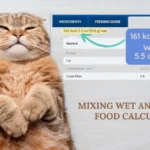Kittens are bundles of energy and curiosity, and one of the most important aspects of raising them is understanding when and how to transition them to dry food. Ensuring your kitten has the proper nutrition is crucial for healthy growth, and knowing when kittens can eat dry food only is an important milestone in their development. This comprehensive article will explore every aspect of transitioning kittens to dry food, including feeding timelines, benefits and drawbacks of dry food, comparisons with wet food, and expert-recommended feeding tips.

Contents
- 1 When Can Kittens Eat Dry Food Only?
- 2 Nutritional Needs of Kittens vs. Adult Cats
- 3 Wet Food vs. Dry Food: Understanding the Differences
- 4 How to Transition Kittens to Dry Food Only
- 5 Sourcing and Manufacturing of Kitten Dry Food
- 6 Recall History of Popular Cat Foods
- 7 What Types of Dry Cat Food Are Available for Kittens?
- 8 Top Dry Kitten Food Recipes Reviewed
- 9 Ingredients and Nutritional Value of Dry Kitten Food
- 10 Customer Reviews and Experiences
- 11 How Our Test Cats Responded to Dry Kitten Foods
- 12 Pros and Cons of Feeding Kittens Dry Food Only
- 13 FAQs About Kitten Feeding
When Can Kittens Eat Dry Food Only?
Kittens can typically transition to eating dry food only between 7–8 weeks of age, though the process of switching from mother’s milk or formula to solid food begins around 5 weeks. By the time they are about two months old, most kittens are ready to rely entirely on solid food, whether it be dry, wet, or a combination of the two.
Key Milestones in Kitten Feeding:
- 4 weeks: Begin transitioning from milk/formula to solid food (softened with water or milk).
- 5–6 weeks: Gradually introduce dry food alongside wet food, with some kittens starting to nibble on softened kibble.
- 7–8 weeks: Kittens should be fully weaned and capable of eating dry food exclusively.
- 4–6 months: Start transitioning kittens to regular meal schedules, potentially reducing the frequency of feeding.
The exact time for switching to dry food depends on your kitten’s individual preferences, development, and health. Some kittens may adapt faster to dry kibble, while others may need wet food mixed in for a while longer.
Nutritional Needs of Kittens vs. Adult Cats
Kittens have distinct nutritional needs compared to adult cats, as they are growing rapidly. Their high energy and protein needs are due to their explosive growth in the first few months of life.
Key Nutritional Differences:
- Caloric intake: Kittens need more calories to support their rapid growth.
- Protein: Kittens require at least 30% of their energy from protein, which is higher than the requirements for adult cats.
- Fats and Amino Acids: They also need more essential fats and amino acids like taurine for proper heart and vision development.
- Vitamins and Minerals: Kittens require higher levels of certain vitamins (e.g., vitamin E and C) and minerals (e.g., calcium for bone development).
For this reason, it’s important to feed them specially formulated kitten food until they reach one year of age. Adult cat food doesn’t meet the higher nutritional demands of growing kittens.
Wet Food vs. Dry Food: Understanding the Differences
When deciding whether to feed your kitten dry food only, it’s important to understand the benefits and drawbacks of both wet and dry food.
Benefits of Dry Food:
- Convenience: Dry food is easy to store, serve, and measure.
- Dental Health: The crunchiness of kibble can help clean your kitten’s teeth by scraping away plaque.
- Cost-Effective: Dry food is usually more economical than wet food.
- Mental Stimulation: Dry food can be used in puzzle feeders to provide enrichment.
Drawbacks of Dry Food:
- Hydration: Dry food lacks moisture, which means kittens need access to plenty of fresh water to stay hydrated.
- Texture Issues: Some kittens may struggle with chewing dry food in the early stages of weaning.
Benefits of Wet Food:
- Hydration: Wet food contains a higher water content, helping kittens stay hydrated.
- Palatability: Wet food is often more appealing to picky eaters because of its soft texture and strong aroma.
Drawbacks of Wet Food:
- Cost: Wet food tends to be more expensive than dry food.
- Storage: Opened cans must be refrigerated, and leftovers can spoil more easily than dry food.
How to Transition Kittens to Dry Food Only
Switching a kitten to dry food should be done gradually to avoid digestive issues and hunger strikes. Here’s a step-by-step guide to ensure a smooth transition:
Step-by-Step Process:
- Start mixing dry and wet food: Around 5–6 weeks, introduce dry food by mixing it with water or wet food to soften it. This will make it easier for the kitten to chew.
- Gradually reduce moisture: Over the next couple of weeks, gradually decrease the amount of water or wet food until the kitten is eating dry kibble without added moisture.
- Observe and adjust: Monitor your kitten’s eating habits and adjust based on their preferences. If they’re struggling with dry food, consider continuing with a mix of wet and dry food for a bit longer.
- Provide plenty of water: Ensure your kitten has access to fresh water at all times, as dry food doesn’t provide the same hydration as wet food.
Sourcing and Manufacturing of Kitten Dry Food
Not all kitten foods are created equal, and the sourcing and manufacturing process can make a big difference in quality.
What to Look for in Quality Dry Kitten Food:
- Reputable Brands: Choose from trusted brands like Hill’s Science Diet, Purina, or Royal Canin, which have undergone feeding trials and have rigorous safety standards.
- AAFCO Certification: Look for the statement “Meets the nutritional requirements established by the AAFCO” on the label.
- Ethical Sourcing: Some brands emphasize sustainable sourcing and high-quality ingredients without harmful additives or preservatives.
Recall History of Popular Cat Foods
Understanding the safety of the kitten food you choose is important. Reputable brands like Purina, Hill’s Science Diet, and Royal Canin rarely face recalls. However, it’s important to stay informed and check the recall history of any food you choose to ensure it’s safe for your kitten.
What Types of Dry Cat Food Are Available for Kittens?
There are several types of dry kitten food to choose from, including grain-free, high-protein, and those formulated for specific health needs (e.g., digestive support).
Common Types of Dry Kitten Food:
| Type | Description | Best For |
| Grain-Free | Lacks grains like corn or wheat. | Kittens with grain allergies or sensitivities. |
| High-Protein | Contains higher levels of protein from meat sources. | Kittens needing extra protein for growth. |
| Digestive Support | Contains prebiotics and fiber to support digestive health. | Kittens with sensitive stomachs. |
Top Dry Kitten Food Recipes Reviewed
Choosing the right recipe for your kitten can be overwhelming, but here are four highly recommended options:
Top 4 Dry Kitten Foods Reviewed:
- Hill’s Science Diet Kitten Healthy Development Chicken Recipe
- Pros: Contains prebiotics for digestive health, highly digestible for sensitive kittens.
- Cons: Slightly more expensive than some other brands.
- Purina Pro Plan Kitten Shredded Blend Chicken & Rice Formula
- Pros: Features live probiotics and a mix of meaty pieces and kibble for enhanced taste.
- Cons: Higher fat content may not suit all kittens.
- Royal Canin Feline Health Nutrition Kitten Dry Food
- Pros: Specifically formulated for kittens with easy-to-digest ingredients and DHA for brain development.
- Cons: Expensive.
- Blue Buffalo Wilderness Kitten Grain-Free Dry Cat Food
- Pros: Grain-free with high protein from real chicken.
- Cons: Some kittens may not digest it as well as other brands.
Ingredients and Nutritional Value of Dry Kitten Food
It’s important to examine the ingredients of any kitten food you choose. Look for whole protein sources like chicken or fish as the first ingredient, and avoid fillers like corn or soy.
Guaranteed Analysis (Example: Hill’s Science Diet Kitten):
| Nutrient | Amount (% as fed) |
| Protein | 33% |
| Fat | 19% |
| Fiber | 3% |
| Moisture | 10% |
Caloric Weight Basis:
| Nutrient | Amount (kcal/kg) |
| Protein | 400 kcal/kg |
| Fat | 180 kcal/kg |
Customer Reviews and Experiences
Many kitten owners have shared positive experiences with transitioning their kittens to dry food. A common trend is that kittens prefer a mix of textures in the beginning but gradually adjust to dry food.
How Our Test Cats Responded to Dry Kitten Foods
Our test cats responded well to most dry kitten foods, especially when a gradual transition was used. The Hill’s Science Diet Chicken Recipe was a favorite due to its palatability and digestibility.
Pros and Cons of Feeding Kittens Dry Food Only
Pros:
- Convenient and easy to store.
- Helps with dental health.
- More cost-effective than wet food.Hill’s Science Diet Kitten Healthy Development Chicken Recipe
- Can be used for mental stimulation with puzzle toys.
Cons:
- Lacks the moisture found in wet food.
- Some kittens may struggle to chew dry kibble early on.
- Requires kittens to drink plenty of water to avoid dehydration.
FAQs About Kitten Feeding
- Q: When should I start feeding my kitten dry food?
A: Start offering dry food around 5–6 weeks, and kittens can eat it exclusively by 7–8 weeks. - Q: How much dry food should I give my kitten?
A: Follow the packaging guidelines for portion sizes based on your kitten’s weight and age.
In conclusion, kittens can transition to dry food only by 7–8 weeks of age if done gradually and with the right nutritional support. Offering high-quality, AAFCO-approved dry kitten food ensures your kitten receives the nutrients they need for healthy growth. Keep water readily available and monitor their development closely to ensure a smooth transition from milk to solid food.



